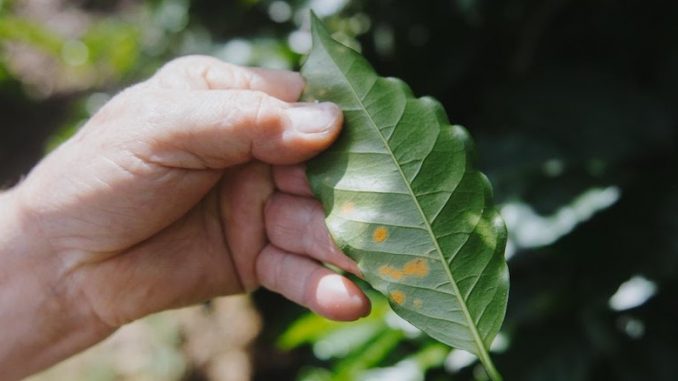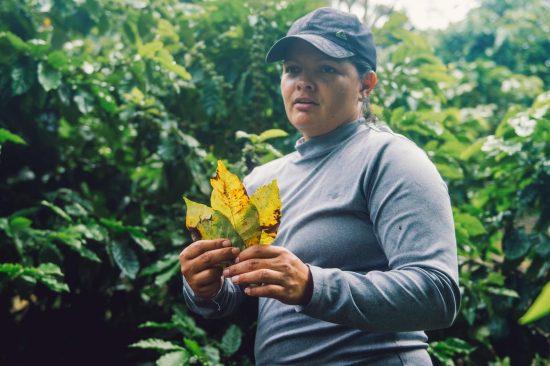
We explore how coffee leaf rust has impacted the world over the last several decades, and how it recently affected coffee-growing regions in Hawai’i.
BY ALEXA ROMANO
SPECIAL TO BARISTA MAGAZINE ONLINE
Photos by Alexa Romano
Coffee leaf rust (CLR) is a disease caused by the fungus Hemileia vastatrix. This destructive disease affects coffee trees and has spread like an epidemic throughout the world’s coffee-producing regions, including Asia, South America, Central America, Africa, and now Hawai’i.

Coffee Leaf Rust
Coffee leaf rust is a fungus that lives on the surface of the coffee leaves. The infection occurs only through the stomata, which shows up as tiny yellow- and orange-colored spots dusted on the undersides of the leaves (hence the name coffee leaf rust). The fungus germinates through the spores and absorbs the coffee plant’s vital nutrients. The more the fungus grows, the more nutrients it absorbs. As a result, coffee leaves shrivel up and fall off, preventing the cherries from fully developing and maturing.
Coffee leaf rust severely devastates coffee production. First discovered in what is now Sri Lanka, coffee leaf rust made its debut in Brazil in 1970. In just a dozen years, the rust had spread to every major coffee-producing country in the Americas. During the 2011-2012 harvest season, Central American coffee farmers sighted the rust spots too. Five years later, the Central American coffee leaf rust epidemic had devastated the region, affecting 70% of farms. According to World Coffee Research, 1.7 million coffee workers lost their jobs and it caused $3.2 billion in damage and lost income.
Solutions
Coffee leaf rust has no cure. Its spread can be reduced to an extent, but not eliminated. World Coffee Research states that plant diseases thrive on five factors: plant genetics (e.g., is the plant resistant to the disease?); management practices (e.g., shade, pruning, and plant nutrition; chemical control (e.g., fungicides and pesticides); the environment; and the disease itself, which can evolve over time.
Since neither the evolution of disease nor environmental factors can be controlled, World Coffee Research suggests that efforts must focus on plant genetics and chemical control. Along with experimenting with new coffee varieties and replanting coffee farms with rust-resistant coffee trees, producers have also used fungicides as an important tool in the management of coffee leaf rust epidemics.
Coffee Leaf Rust in Hawai’i
Hawai’i and consequently the United States had yet to confirm its first coffee leaf rust case. However, in October 2020, the Hawai’i Department of Agriculture (HDOA) confirmed its first case of coffee leaf rust in Maui and the Big Island of Hawai’i.
Following this confirmation, Hawaii Gov. David Ige declared an emergency for the industry in February 2021 and restricted movement of coffee plants, plant parts, and certain materials on those islands. In March 2021, the HDOA filed a request to the U.S. Environmental Protection Agency (EPA) for a specific exception to allow the use of the fungicide Priaxor Xemium on coffee plants. Usually, this fungicide is used to control fungi on other crops such as leafy vegetables, strawberries, and soybeans, but not specifically on coffee. EPA approved the request on May 19 for Hawaiian coffee plants.
In recent years, coffee has been a roughly $50 million industry in Hawai’i, and the second-biggest crop in the state by value. The HDOA claimed that estimated crop losses can range from 30% to 80% The push to implement fungicide follows the fear of losing coffee production yield. However, what will the other impacts on the ecosystem be because of the use of chemicals to treat coffee leaf rust? For now, the value of coffee is primary.
The HDOA and the University of Hawai’i’s College of Tropical Agriculture and Human Resources hosted two webinars in April that were designed to inform coffee growers on the use of Priaxor Xemium. Additionally, Hawaiian coffee farmers planning to implement this fungicide must follow a specific protocol: They must follow the label instructions, inform HDOA’s Pesticides Branch via email at least seven days prior to using the fungicide, and report use within 10 days of application. Find out more on the HDOA Pest Advisory Form.

Alexa Romano (she/her) is a recent graduate from Stanford University with an MA and BA in Cultural and Social Anthropology with a double minor in Ethics in Society and Photography. Her research investigates the coffee commodity chain and looks at the mystified, obscured, and ethical/unethical relations that tether producer societies to consumer societies with a particular focus on Costa Rican smallholder producers. In addition to freelance writing, Alexa is an HIIT instructor with a wellness tech company. Currently, she is learning barista skills at Ritual Coffee in San Francisco. See Alexa’s work here.

